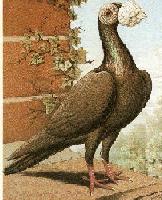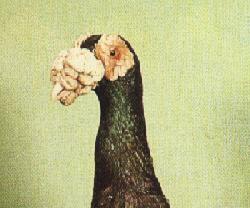
| The Pigeon Cote Presents: the Carriers |
 |
Carriers are among the oldest fancy breeds. Carriers are descendants of the old "homing" pigeons of Persia, where they were used to carry messages. A fellow named Aldrovandi described them as early as 1610. A few years later, Ludlow drew the above drawing. Charles Darwin spoke of the Carrier in his famous work Variation of Animals and Plants Under Domestication. Now, you may think that this very old drawing is probably a bit of an exaggeration. How could any pigeon look like that? Well, click here to see a photograph of a white one of these carriers today, and you be the judge. Care to see a black, click here? |
 |
Only a few other breeds can affect people so differently.
Carrier Fanciers, as they are known in the pigeon breeding hobby, call
this breed the king of all the pigeon breeds, while others find this the
most downright ugly of all breeds in existence. Few people seem to
take the middle ground.
|
Carriers belong to the group of wattle pigeons that originated in England. Carriers have a wattle with a walnut-like structure. The upper half is takes three years to develop. The lower half is somewhat smaller. The wattle is not supposed to grow into or contact the eye ceres. After the third year, the wattle begins to develop very small knobs. Just take a close gander at the photos. You may have noticed that the modern day Carriers have even longer legs than the one in Ludlow's picture. The best specimens are large, muscular, and are of vertical station, meaning that they stand nearly upright as opposed to horizontal as feral pigeons do. The feathering is tight to the body. While it is a rather large pigeon, the Carrier can actually be quite timid. Only minimum attention is required for their breeding. They come in a variety of colors, including black, white, red, yellow, blue bar, bluesilver, dun, ash red, cream, brown, and khaki. Do one of you Carrier aficionados have a picture of one of these other colors you would care to share? Even though the Carrier was developed in previous centuries as a flying, message carrying pigeon, modern day Carriers are not good fliers. |
|